The history of marijuana is a long one, and its uses and reputation have evolved over time. It is believed that marijuana originated on the steppes of Central Asia (in the regions that are now Mongolia and southern Siberia). The nutrient-rich dump sites of prehistoric hunters helped the cannabis plants flourish there up to 12,000 years ago.
In fact, cannabis is one of the humanity’s oldest cultivated crops. Despite this, tracing the plant through marijuana history finds it becoming demonized and ultimately banned in many places. Before that point, however, marijuana was one of the most useful and celebrated plants on the planet.
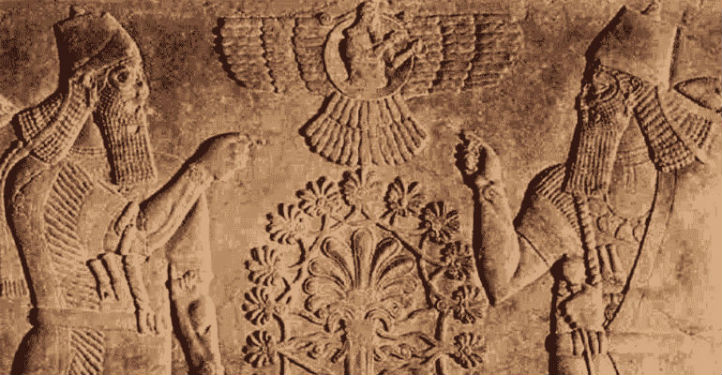
Early marijuana history dates the plant back as far as 12,000 years ago.
The Origins of Cannabis
Among some of the most interesting cannabis information is the history of the ancient plant. Thousands of years ago, the Chinese used both industrial hemp and psychoactive marijuana. A look into Chinese history provides not only a glimpse into the origin of marijuana; it also offers a look into the history of medical marijuana. No part of the cannabis plant was wasted; they used the root for medicinal purposes and made cloth, paper, and rope from the stems. The leaves and THC-rich flowers, meanwhile, were used as intoxicants and as medicines. Cannabis was used as a surgical anesthetic; they were also used by Emperor Shen Nung for rheumatism and gout.
Hemp seeds were set aside for food and to be pressed for oil. Cannabis seeds were used as grains in ancient China, and the people often filled sacrificial vessels inside tombs with hemp to send loved ones off into the afterlife.
The ancient Egyptians also used cannabis; historians learned this from deciphering historic scrolls from circa 2000 B.C. In Egypt, cannabis was used as a medical treatment for sore eyes and cataracts. Cannabis pollen (also known as kief) was also found on Ramses II, perhaps one of the most famous mummies in ancient Egyptian history.
About 2000 B.C., cannabis arrived in Korea (brought by coastal farmers) and between 2000 B.C. and 1000 B.C., it made its way to India. It was so revered there that it is mentioned in one of the ancient Sanskrit Vedic poems as being one of “five kingdoms of herbs […] which release us from anxiety.” Medical use of the plant in the Middle East is recorded in 700 B.C. in the Venidad, an ancient Persian religious text which is said to have been written by Zoroaster, an ancient Persian prophet.
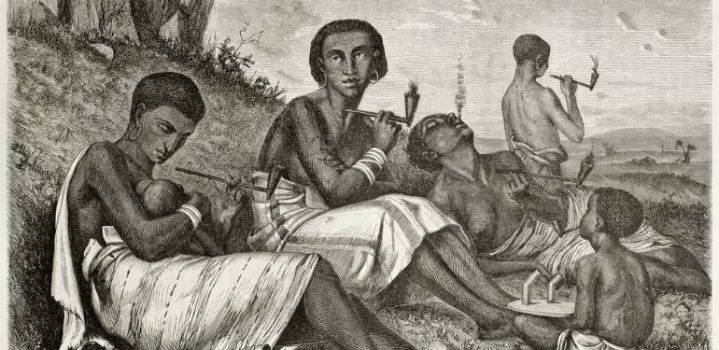
Cannabis originated in ancient China centuries ago, and people have been using it for industrial and medicinal purposes ever since.
Cannabis Moves Out of Asia
The next chapter in the history of cannabis is compliments of the Scythians, a group of Eurasian nomads. They brought the plant from the Altai mountains into Germany. The Scythians not only used cannabis fibers to weave clothing; they also bathed themselves in its fragrant smoke.
The Greek origins of marijuana take root as early as 200 B.C. There, it was used as a remedy for edema, earache, and inflammation. Around the 5th century, cannabis began appearing in Britain. It was so valued there that it even made an appearance as an illustration in the Grandes Heures of Anne of Bretagne (a book of hours created circa 1505-1508).
In 1799, marijuana history takes a detour to France, where Napoleon introduced it after bringing it back from Egypt. His troops had discovered hashish there after being unable to find alcohol (due to Egypt being a Muslim country). In Egypt, marijuana was valued for its sedative and pain relieving qualities. The French troops immediately took to the hashish and brought a supply of it back home with them. Beyond an enjoyment of psychoactive THC-rich marijuana, hemp was also an important cash crop in France.
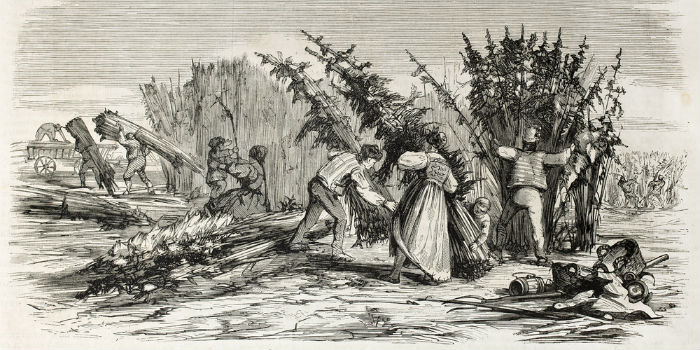
Hemp being harvested along the banks of the Rhine River.
History of Marijuana in the U.S.
The next chapter in cannabis history unfolds in the U.S. many years before it became the United States. The Spanish encouraged hemp farming in their South American colonies in the mid-1500s. Later, the English did the same at Jamestown in the early 1600s. There, hemp became a popular commercial crop together with tobacco.
By the late 1700s, cannabis farming had taken root in Mexico, as well as in the Spanish colonies in the province of California. Subsidies for the latter dried up after the Mexican Revolution of 1810.
By 1850, marijuana had fully caught on in the U.S. It even appeared in the United States Pharmacopeia (an authority that sets standards for all prescription and over-the counter medications). It approved marijuana as a treatment for a number of diseases including “neuralgia, tetanus, typhus, cholera, rabies, dysentery, alcoholism, opiate addiction, anthrax, leprosy, incontinence, gout, convulsive disorders, tonsillitis, insanity, excessive menstrual bleeding, and uterine bleeding,” as well as others.
Starting in 1910, however, an influx of immigrants came over the U.S. border hoping to escape the Mexican Revolution. They brought marijuana with them and suddenly cannabis was viewed with suspicion by many Americans. It was also viewed with suspicion by people like William Randolph Hearst and the Dupont family – heads of corporations for whom hemp posed serious competition due to its ability to be turned into paper and cloth.
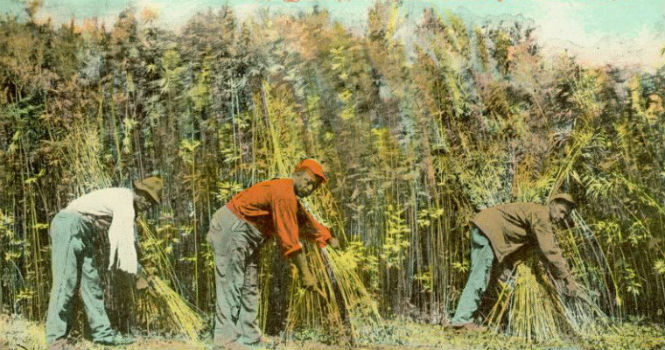
At one point in cannabis history, hemp was an important cash crop in places like Kentucky.
Cannabis Prohibition in the U.S.
The next chapter in the history of marijuana is one of cannabis prohibition. Corporate interests and anti-immigrant sentiment began to turn people in the U.S. against all forms of cannabis, and fearing social degeneration and addiction, states started passing laws prohibiting all forms of it. Although the plant had previously been known as “cannabis” in the US, anti-cannabis activists began referring to it using its Mexican name, “marihuana,” in order to further tie its use to immigrants.
Utah outlawed cannabis in 1915, and by 1931, it was illegal in 29 different states. In 1930, Harry Aslinger became the first commissioner of the Federal Bureau of Narcotics (FBN) and worked to outlaw cannabis at the federal level. In 1937, the Marijuana Tax Act effectively criminalized possession of the plant throughout the U.S. The act also put cannabis under the regulation of the Drug Enforcement Agency (DEA). Over time, a growing number of countries passed their own prohibition laws until cannabis was largely illegal around the globe.
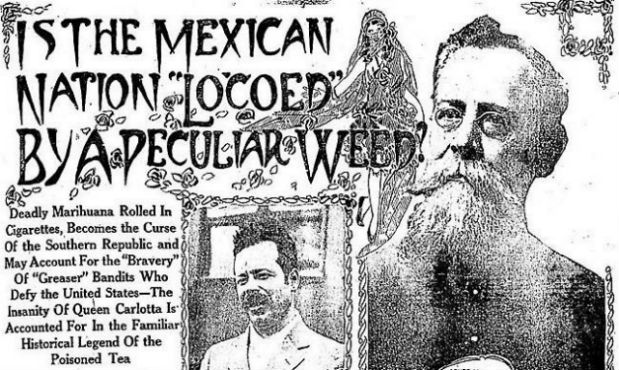
An anti-immigrant backlash helped push forward prohibition of marijuana in the U.S.
Cannabis History in the UK
Marijuana was also popular in the 19th century in Europe. It was widely used for medical purposes in the UK before eventually facing a backlash and prohibition. Even Queen Victoria was given cannabis by her doctor to relieve menstrual pain. Marijuana was widely used as a medical treatment until the syringe was invented in the late 1800s. Because marijuana can’t be dissolved and injected, it fell out of favor and was replaced by other faster-acting medications, in addition to newer drugs such as aspirin.
In 1928, marijuana was officially outlawed in the UK. This came as a result of a 1928 international drugs conference held in Geneva. There, an Egyptian delegate put forth a convincing argument that cannabis rivaled opium in being a menace to society. While recreational use continued on in the Soho jazz clubs in 1950s London, as well as throughout the flower power era of the 1960s, it did so under a veil of criminality. During the flower power years of the sixties it also soared in popularity, despite remaining completely illegal.
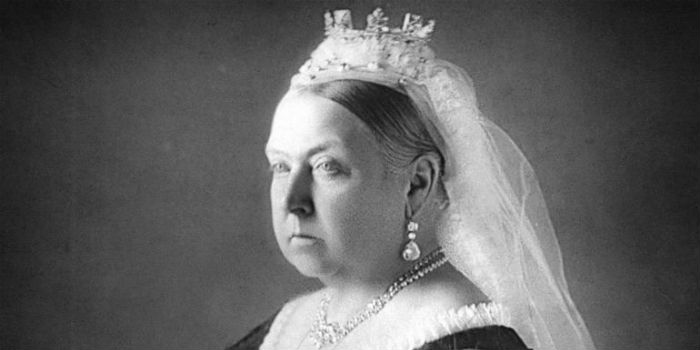
Queen Victoria used marijuana to help control her menstrual pain.
FAQ About Marijuana History
Because the plant has long been shrouded in stigma and mystery, the topic of marijuana history generates many questions. Here are some of the ones that arise most frequently.
Where did marijuana originate?
The first evidence of marijuana comes from Central Asia (the parts that are now southern Siberia and Mongolia). Thousands of years ago, areas where hunters would typically dump the leftovers from their kills became fertile breeding grounds for wild cannabis plants.
How long has marijuana been around?
The history of marijuana goes back to at least 12,000 B.C. That’s when the wild cannabis plants grew throughout Central Asia. There is evidence that the plants were used by humans during those times, with cannabis farming coming soon thereafter.
Who invented marijuana?
No one invented marijuana. Although the history of cannabis is full of cultures that farmed it both for medical and recreational use, the earliest known existence of marijuana plants places it growing wild in Central Asia around 12,000 B.C.
Who was the first person to smoke marijuana?
Online myths say the first medical use was recorded in 2727 B.C., but as the first instances of Chinese written language didn’t occur until after 1200 B.C. the first use of marijuana may stay forever shrouded in mystery.
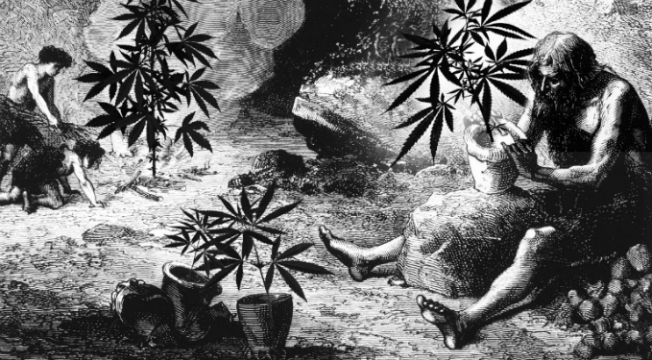
Because cannabis history stretches back so far, no one really knows who discovered marijuana.
Cannabis Use Today
The history of marijuana is a long and mysterious one, but in recent years, the plant has started to emerge from the shadows once more. With legalization in a growing number of places, people are once more enjoying the recreational and medical benefits of cannabis. Some nations such as the Netherlands have decriminalized marijuana possession in coffee shops. In 2001, Portugal became the first European country to officially abolish criminal penalties for personal possession of drugs, including marijuana. In 2018, Canada legalized marijuana for recreational use, and a growing number of U.S. states have legalized its use.
Many strong laws remain in place, particularly for the cultivation, distribution and selling of cannabis in all its forms. Punishments in some countries range from cautions to fines and even jail sentences in some cases. Still, the final chapter in the book of marijuana history seems to be one of increasing legalization, with the final pages still waiting to be written.
Category Pages:
- Cannabis 101 - Cannabis information guide that ranges from cannabis culture to consumption methods.
- Cannabis and Cryptocurrency - A detailed guide to cryptocurrency and the cannabis industry.
- Cannabis and Driving - The effects of marijuana on driving; cannabis and professional drivers.
- Cannabis and Gaming - Marijuana's effect video game performance and why top gaming organizations are banning it.
- Cannabis and Parenting - A guide to the challenges parents face teaching kids about cannabis and navigating their own use while remaining responsible parents.
- Cannabis Decarboxylation - What decarboxylation does, as well as choosing the best decarb methods.
- Cannabis Facts - Fascinating info about cannabis history, facts about medical marijuana, and more.
- Cannabis Home Decor - A guide to chic and sophisticated 420 decoration ideas.
- Cannabis Prohibition - A guide to the history of marijuana prohibition in the U.S.
- Cannabis Tea - A guide to marijuana tea effects, its benefits, and how to make THC and CBD tea.
- Cannabis Technology - An overview of the ways marijuana technology has changed the cannabis industry.
- Cannabis Terpenes - A 101 guide to the uses, medical benefits, and research on marijuana terpenes.
- Cannabis Tourism - A guide to marijuana tourism in places with legal cannabis around the world.
- Federal Marijuana Legalization - Who are the biggest players in the fight against federal marijuana legalization in the U.S.A.?
- History of Cannabis - (CURRENT PAGE)
- What Is 420? - What does 420 mean? A guide to the symbolism and origin of 420, as well as 4/20 day celebrations around the world.
- Cannabinoids - Exploration of cannabinoids, their effects, and their health benefits.
- Cannabis Types - A guide to the different types of marijuana: sativa, indica, hybrids, hemp, and ruderalis.
- Concentrates & Extracts - An exploration of cannabis concentrates & extracts from BHO and beyond.
- Cannabis & Health - A guide to the many benefits of marijuana, including medical and general health uses.

 Author: John White
Author: John White